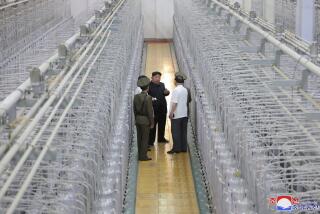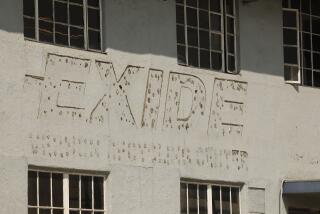Nuclear Security Fixes Urged
- Share via
Amid growing concern that nuclear weapons labs are vulnerable to a terrorist attack, senior Energy Department officials are seriously considering major steps to improve security -- including the removal of plutonium and highly enriched uranium from Lawrence Livermore National Laboratory and other weapons sites.
A classified directive issued late last year ordered the department, which already was examining the security of its weapons-grade nuclear materials, to consider consolidating them in fewer locations, according to congressional sources.
Energy officials said Monday that security at their facilities was “strong.” But they acknowledged that they were reviewing proposals to improve protection by consolidating the sites where the government stored plutonium and highly enriched uranium -- the elements essential to a nuclear bomb.
The pace of improvements, however, has left many outside experts and leaders in Congress dissatisfied.
Rep. Christopher Shays (R-Conn.), chairman of the House national security subcommittee, said that the system remained vulnerable and that the Energy Department was underestimating the threat it faces. Shays’ committee is to have a hearing on the matter today.
The Energy Department has nuclear materials in at least seven major weapons sites across the nation, but Livermore -- 44 miles southeast of San Francisco and surrounded by residential communities -- is closer to a major metropolitan area than the others.
In the last year, the Energy Department has increased its assumptions about the size and firepower of terrorist teams that could assault its labs. Government officials now say that anyone bent on attack probably could use high-powered explosives to punch holes though reinforced concrete walls and then be able to penetrate razor wire fencing and defeat the most sophisticated electronic surveillance systems.
But the General Accounting Office, an arm of Congress, will report today that the threat posed by terrorists against the nation’s weapons labs is estimated by intelligence agencies to be far more lethal than what the Energy Department has accepted in its most recent planning for security.
The bomb-making materials at Livermore have received particular attention, based on concerns about the site’s vulnerabilities. The materials are kept in a fenced area known as the Superblock, situated about a quarter-mile from a residential tract.
Unlike the security forces at other weapons sites, Livermore’s personnel do not have certain high-powered weapons, door-breaching explosives or helicopters to defend the site. Superblock is packed into the dense Livermore complex, making it tougher to defend than remote facilities, security experts said.
The most serious concern is that a highly trained suicide terrorist team could penetrate Superblock or any Energy Department site and construct a crude bomb known as an improvised nuclear device.
During a 2002 Senate hearing, Energy Department weapons experts estimated that a bomb with a yield of 1 kiloton could be built in minutes by terrorists once they gained access to the materials. Such a bomb would destroy the lab, the surrounding city and cause tens of thousands of casualties, the experts warned. A lesser, although still lethal threat, would be a “dirty bomb,” in which radioactive materials would be dispersed into the air.
Before the Sept. 11 attacks, such a scenario was never considered. But Energy officials have come to accept the potential of such suicide squads and have dramatically changed their strategy. The goal in the past was to prevent the theft of plutonium and to contain any terrorist who would enter a lab. Now, the goal is to deny entry -- a far more difficult task.
A training video produced by the Energy Department shows terrorists defeating the most intensive security measures, using devices called platter charges that destroy thick concrete and lasers to blind surveillance cameras. The teams are shown moving with lightning speed, penetrating buildings in seconds after alarms go off.
“We have concluded, working with insiders, that Livermore cannot adequately protect its materials,” said Danielle Brian, executive director of the Project on Government Oversight, a Washington, D.C., group that has been pressing the Energy Department to improve its security. “The only way to address the problem is to get those materials out of there.”
The group has asked Energy officials to eliminate the materials from Livermore and two sites in Idaho -- and to move plutonium to underground sites in Tennessee and South Carolina.
Brian said she met with Energy Secretary Spencer Abraham on Jan. 22 to recommend that the department move the Livermore materials to the Nevada Test Site’s defense assembly facility, an underground lab located in a remote desert. “He seemed genuinely concerned and committed to fixing the problem,” she said.
Energy spokesman Bryan Wilkes acknowledged Monday that the department was looking at consolidating or removing nuclear materials at a number of sites. Earlier this year, it decided to remove the materials from TA-18, a weapons site at Los Alamos National Laboratory in New Mexico.
“It is part of the consolidation process that we are doing,” Wilkes said. “We are always driving to reduce our nuclear materials.”
But eliminating the materials from Livermore would be controversial -- and opposed by the lab. “The lab’s plutonium facility is a vital national-security asset,” said Livermore spokesman David Schwoegler. “Its work is ... conducted under the highest security conditions.”
Schwoegler added that Livermore recently went through a security assessment that resulted in its protective force earning a rating of “effective performance,” the highest possible.
Livermore is one of two national labs that design nuclear weapons. Work done at the lab aided in the development of the hydrogen bomb and the miniature nuclear bombs for missiles that carry multiple warheads. It is expected to play a key role in future efforts to modernize the nuclear weapons program.
The exact amount of nuclear materials at Livermore is not known, but it is estimated that the site has between half a ton and a ton of plutonium alone. Any decision to move it to Nevada would probably take years and require substantial investments to duplicate the technical capabilities at Superblock.
Although Energy Department officials say their security is strong, outside experts have raised a number of serious questions.
In the last three years, the Energy Department and its contractors have fired more than half a dozen employees who expressed concerns about security. Several of the employees were reinstated under court orders.
Mathew Zipoli, vice president of Livermore’s Security Police Officers Assn., said his group had asserted that there were major deficiencies in training, equipment and personnel practices at the lab. After earlier providing information to the Energy Department’s inspector general about security problems at Livermore, Zipoli was fired. He was later reinstated.
“The equipment is extremely inadequate,” Zipoli said, adding that he could not discuss the specifics of the problem. “We have made the case that we are under-gunned to handle the adversarial threat.”
Zipoli said Livermore guards were not sworn federal law enforcement officers, meaning they did not qualify for life insurance or disability if they were injured defending the lab. “How can you expect somebody to die defending this lab when nobody will provide for their families afterward?” he asked.
Marylia Kelly, who heads the community group Tri-Valley CAREs -- Communities Against a Radioactive Environment in the town of Livermore, said a large housing tract was within view of the tritium towers inside Superblock.
“This site is very difficult to defend,” said Kelly, whose group has sued to block the construction of a biological research lab at Livermore. “The site is very compact. The buildings are cheek to jowl.”
In an interview Monday, Shays said a number of Energy labs would be difficult to defend because communities had begun encroaching on what were once wide-open fields and because the sites were too densely packed with buildings.
“The Energy Department has too many sites, and the sites are too old,” Shays said.
*
(BEGIN TEXT OF INFOBOX)
Plutonium storage sites
Sites where the government stores plutonium, in metric tons.
1. Rocky Flats, 12.9 MT 2. Hanford, 11.0 MT 3. Argonne National Laboratory West, 4.0 MT 4. Los Alamos National Laboratory, 2.6 MT 5. Savannah River, 2.1 MT 6. Idaho National Engineering and Environmental Laboratory, 0.5 MT 7. Lawrence Livermore National Laboratory, 0.4 MT
* Pantex is the Dept. of Energy site where nuclear weapons are assembled and disassembled. Source: Department of Energy
More to Read
Sign up for Essential California
The most important California stories and recommendations in your inbox every morning.
You may occasionally receive promotional content from the Los Angeles Times.











